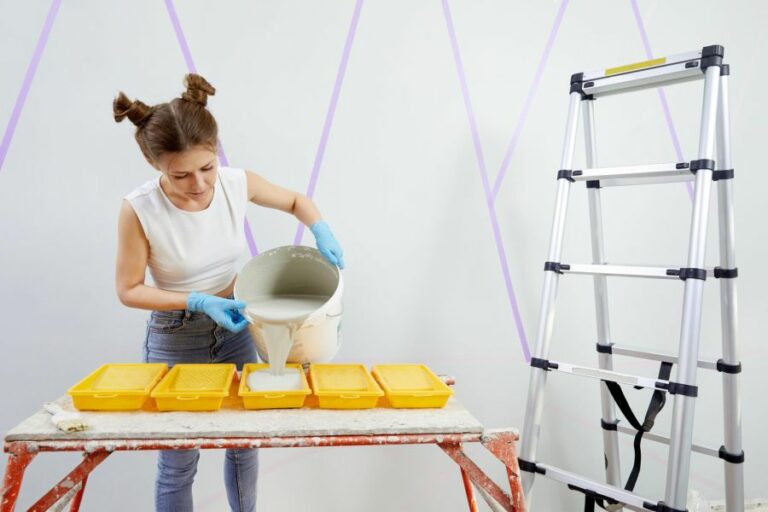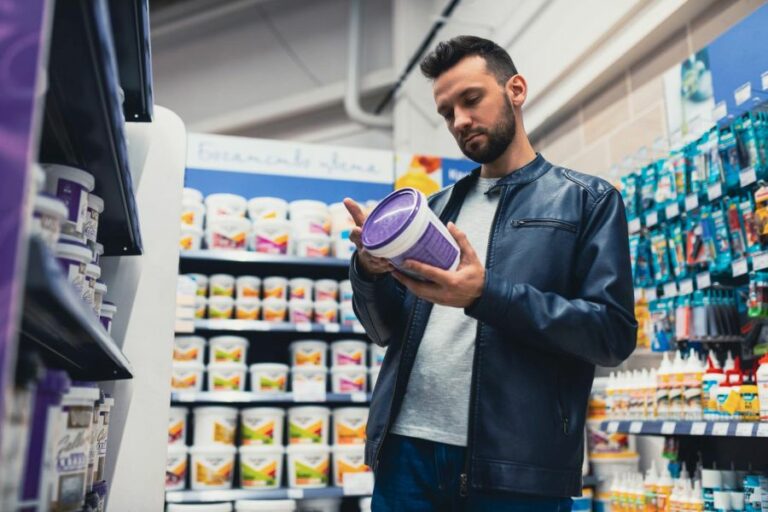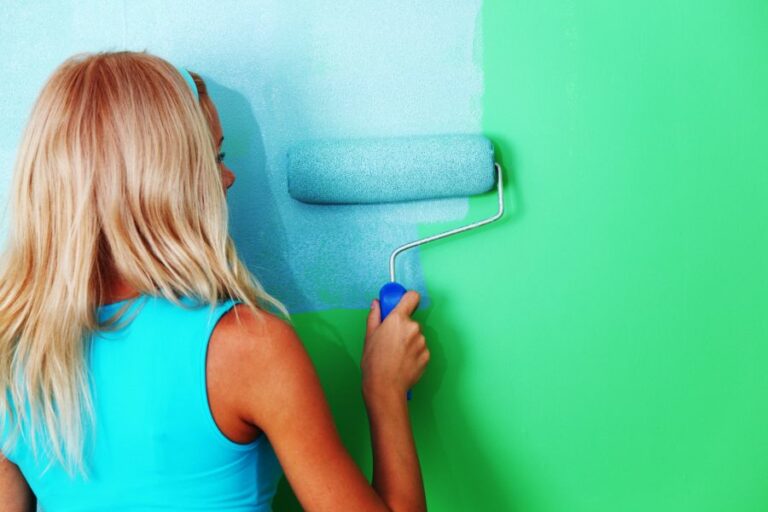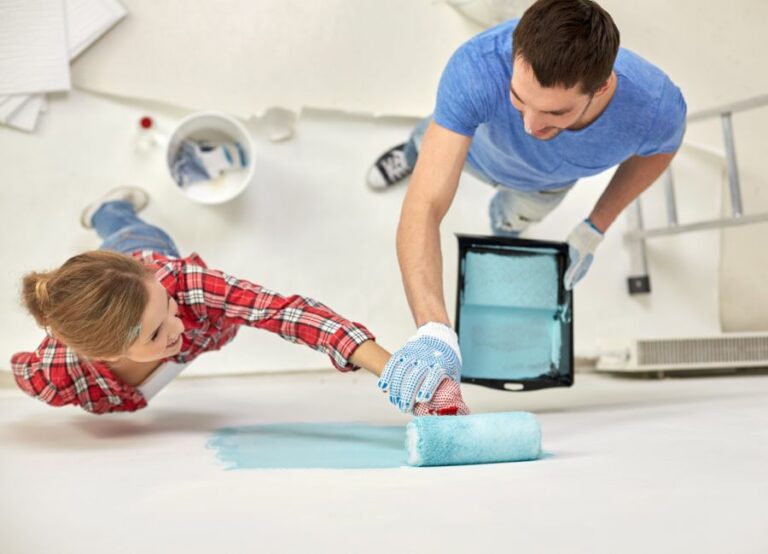Moisture-Resistant Interior Painting Solutions. What Pros Say
Worried about moisture causing damage to your interior paint? It’s time to relax! I have the perfect moisture-resistant interior painting solutions for you. Say goodbye to those pesky peeling walls, and let’s discuss how you can preserve the pristine appearance of your indoor spaces.
Moisture-resistant interior painting solutions:>
Moisture-resistant interior painting solutions, such as acrylic, latex, and epoxy paints, protect against dampness and humidity in homes and buildings. These specially formulated paints create a barrier that prevents moisture penetration, preserving the appearance and durability of walls, ceilings, and floors. To maximize resistance, choose the appropriate paint type for your space, prepare the surface, apply primer, use multiple coats, and maintain proper ventilation.

Discover the range of moisture-resistant interior painting solutions designed to protect your walls from mold, mildew, and water damage. Say goodbye to unsightly peeling paint and hello to a beautiful, long-lasting finish. Intrigued? Read on to find the perfect solution for your home.
Contents
- 1 Interior Painting Solutions for Moisture Resistance
- 2 Top Interior Paints for Moisture Protection
- 3 High Moisture Wall Paints: Identifying the Best
- 4 Mildew-Preventing Paints: Are They Available?
- 5 Water-Resistant Paint: Discovering the Best Options
Interior Painting Solutions for Moisture Resistance
• Introduction
Moisture-resistant paints have become increasingly popular in recent years because they provide long-lasting protection against dampness and humidity inside homes and buildings.
These paints are formulated with special additives that create a moisture barrier, preventing it from penetrating the surface of the wall, ceiling, or floor.
• The Importance of Moisture Resistance in Paint
Humidity and moisture are significant concerns in many homes, especially in areas prone to high levels of humidity, such as bathrooms, kitchens, and basements.
Excessive moisture can lead to a host of problems, including mold and mildew growth, paint peeling, and damage to the structural integrity of the building.
Using moisture-resistant paints can mitigate these issues by providing a protective barrier against dampness, thereby preserving the aesthetic appeal of your interior spaces and increasing the overall durability of your walls and ceilings.
Furthermore, some moisture-resistant paints also offer additional benefits, such as antimicrobial properties, which can help prevent the growth of mold and mildew.
• Types of Moisture Resistant Paints
– Acrylic and Latex Paints
Acrylic and latex paints are the most common types of moisture-resistant paints. They are water-based, which allows them to form a flexible, breathable film on the applied surface.
This film prevents moisture from penetrating the paint while still allowing the surface to release any trapped moisture, preventing paint from peeling and bubbling.
Acrylic and latex paints are versatile and can be used on various substrates, such as concrete, plaster, and drywall. They also come in a wide range of finishes, from matte to high gloss, allowing for various design options when choosing your interior paint.
– Epoxy Paints
Epoxy paints are another moisture-resistant paint that is predominantly used on concrete and masonry surfaces, making them ideal for basements and garages.
These paints are made of two components: epoxy resin and a hardener, which, when mixed, create a highly durable, chemical-resistant coating that effectively seals surfaces against moisture.
Epoxy paints have several advantages over acrylic and latex paints, such as increased durability, stronger adhesion, and better chemical resistance, making them suitable for more demanding environments. However, they are more challenging to work with due to their specialized application process and shorter pot life.
• Tips for Choosing and Applying Moisture Resistant Paints
1. Assess Your Needs
Before purchasing moisture-resistant paint, it’s essential to assess the specific needs of your space. Consider factors such as the level of humidity in the area, the type of substrate you’ll be painting, and the desired finish.
This will help you choose the most suitable type of moisture-resistant paint for your project.
2. Prepare the Surface
Proper surface preparation is crucial to ensure the best possible adhesion of your moisture-resistant paint. Begin by cleaning the surface thoroughly, removing any dirt, grease, or previous paint that may hinder the new paint’s adhesion.
If there are any existing signs of mold or mildew, these should be treated with an appropriate cleaner before painting.
3. Apply a Primer
Using a primer before applying your moisture resistant paint can improve the overall adhesion, coverage, and durability of the paint. Choose a primer designed specifically for damp or humid environments, such as a mold-resistant primer, to enhance the paint’s moisture resistance.
4. Apply Multiple Coats
To achieve maximum moisture resistance, it’s essential to apply multiple coats of paint. Follow the manufacturer’s guidelines for drying times between coats and apply at least two coats to ensure a uniform, protective layer on your surface.
5. Maintain Proper Ventilation
It’s crucial to maintain proper ventilation in your space to reduce humidity levels and prevent the growth of mold and mildew. Invest in an exhaust fan or dehumidifier, especially in areas like bathrooms and kitchens, to help control moisture effectively.
• Conclusion
Moisture-resistant interior painting solutions are an effective way to protect your home or building against the negative effects of humidity and dampness.
By selecting the appropriate type of paint, properly preparing your surface, and following application best practices, you can achieve a long-lasting, moisture-resistant finish, keeping your space looking fresh and functional for years to come.
For more in-depth information on moisture-resistant paints, consider visiting the U.S. Environmental Protection Agency (EPA) website for guidelines on moisture control strategies and maintaining healthy indoor environments.
Top Interior Paints for Moisture Protection
Finding the right interior paint to protect your walls from moisture can be a daunting task with so many options available in the market today.
• Understanding the Importance of Moisture-Resistant Paint
Moisture can have detrimental effects on the structural integrity of your home, leading to numerous issues such as mold, mildew, flaking, peeling, and even warping of the structure. By using moisture-resistant paint, you are ultimately safeguarding your home from these potential problems.
Therefore, it is crucial to invest in high-quality paint to ensure the longevity and health of your home.
– Paint Types and Characteristics
There are two primary types of interior paint that you may consider for moisture resistance: water-based and oil-based.
- Water-based paint (also known as latex or acrylic paint): This paint is the more popular choice among homeowners because it is easier to apply, dries quickly, and has a low volatile organic compound (VOC) content. Due to its flexibility, water-based paint can expand and contract with changes in humidity, making it ideal for moisture-prone areas.
- Oil-based paint: Although more difficult to work with and has higher VOC content, oil-based paint is known for its durability and resistance to moisture, making it a suitable option for moisture-prone areas as well.
It is important to note that the finish of the paint also plays a crucial role in its moisture resistance. High-gloss and semi-gloss finishes tend to be more resistant to moisture and easier to clean compared to flat or matte finishes.
• Recommended Moisture-Resistant Paints
Based on my experience, the following paints have proven to be effective against moisture-related issues in interior spaces:
1. Benjamin Moore Aura Bath & Spa
This top-of-the-line water-based paint is specifically designed for humid and moisture-prone areas in your home, like bathrooms and spas.
With its superior quality and durability, Benjamin Moore Aura Bath & Spa paint features a matte finish that can withstand the harsh conditions of these areas, preventing mildew growth and maintaining a fresh and clean look.
More information on this product can be found here.
2. Zinsser Perma-White Mold & Mildew-Proof Interior Paint
Available in both water-based and oil-based formulations, this paint offers excellent moisture resistance, preventing mold and mildew growth for up to five years. Zinsser Perma-White Mold & Mildew-Proof Interior Paint is ideal for use in bathrooms, kitchens, basements, and other high-humidity areas.
Additional information on this product can be found here.
3. BEHR Premium Plus Ultra
This is another high-quality water-based interior paint that provides excellent moisture resistance, easy application, and quick drying time. Available in a wide range of finishes, BEHR Premium Plus Ultra paint is suitable for use in all areas of the house, including those prone to moisture.
More details can be found on their website.
• Preparing Your Walls for Paint Application
Before you begin painting your walls, proper preparation is crucial to ensure the best possible results. Here are some steps to follow:
- Clean the surface and remove any dirt, dust, and grease. This can be done with a solution of mild detergent and warm water. Rinse well and allow the surface to dry completely.
- Check for any cracks or holes and repair them with the appropriate patching material. Sand the area smoothly when it is dry.
- Apply a high-quality primer to ensure an even and long-lasting finish. A mold-resistant primer can provide an added layer of protection against moisture.
- Apply the moisture-resistant paint of your choice, following the manufacturer’s instructions for optimal results.
• In Conclusion
Investing in high-quality, moisture-resistant interior paint can save you the headache of constant maintenance and repairs caused by moisture-related problems.
Based on my experience, I highly recommend Benjamin Moore Aura Bath & Spa, Zinsser Perma-White Mold & Mildew-Proof Interior Paint, and BEHR Premium Plus Ultra as top contenders for the best interior paint for moisture.
Remember to adequately prepare your walls before applying the paint, as this is essential in ensuring a long-lasting, durable finish.
Rank | Paint Brand | Type | Key Features |
|---|---|---|---|
1 | Benjamin Moore Aura Bath and Spa | Acrylic Paint | Mildew resistant, withstands high humidity and moisture, low odor |
2 | Zinsser Perma-White | Water-Based Paint | Long-lasting, mold and mildew-resistant, self-priming |
3 | Sherwin-Williams Duration Home | Latex Paint | Washable, moisture resistant, mildew resistant |
4 | Behr Premium Plus | Acrylic Paint | Zero VOCs, mildew resistant, durable finish |
5 | Glidden Diamond | Latex Paint | Low VOC, mildew resistant, easy application |
High Moisture Wall Paints: Identifying the Best
• Understanding Moisture Problems
Before diving into the best paint for high-moisture walls, it’s crucial to understand the root cause of the issue. High moisture walls usually occur due to poor ventilation, damp conditions, or a leak in the building’s exterior.
This can lead to mold and mildew growth, structural damage, and a host of health problems. To deal with these issues effectively, proper ventilation, insulation, and waterproofing are essential steps that must be taken before applying the appropriate paint.
For more information on moisture problems in homes, you can refer to this article by the U.S. Environmental Protection Agency, which provides helpful tips and guidance.
• Types of Interior Paints Suitable for High Moisture Areas
There are different types of interior paints available for high-moisture walls. The two most commonly recommended options are water-based and oil-based paints. Each has its own set of advantages and drawbacks depending on the specific requirements and environment.
– Water-Based Paints
Water-based paints, also known as latex or acrylic paints, are the most popular choice for high-moisture walls due to their inherent resistance to mildew and ease of application. These paints dry quickly, emit fewer odors, and can be easily cleaned up with water.
Some examples of water-based paints suitable for high-moisture walls include:
- Acrylic paint: Acrylic paint is durable, versatile, and resistant to both moisture and general wear and tear. It is a popular choice for both interior and exterior use.
- Bathroom and kitchen-specific paints: These paints are formulated specifically for high-humidity areas and have in-built mildew resistance. They provide a tough, long-lasting finish that can withstand frequent cleaning and scrubbing.
– Oil-Based Paints
Oil-based paints, often referred to as alkyd or enamel paints, offer excellent adhesion and create a hard, durable finish. They are less affected by moisture, making them suitable for high-humidity areas.
Some downsides of oil-based paints are that they take longer to dry, emit strong odors, and require special solvents for cleanup. Examples of oil-based paints suitable for high-moisture walls include:
- Alkyd paint: Alkyd paint is oil-based and offers excellent adhesion and durability. It is ideal for high-moisture walls, as it can create a hard, moisture-resistant finish.
- Oil-based primers: Primers are essential for providing a solid foundation for the paint to adhere to. Oil-based primers are more effective on high moisture walls as they create a barrier that prevents water from penetrating the surface.
• Key Factors to Consider When Choosing Paint for High Moisture Walls
– Mold and Mildew Resistance
Mold and mildew growth are common problems in high-moisture areas. It’s essential to choose a paint that has anti-mildew additives or is formulated specifically for use in damp environments. This will help protect your walls from fungal growth and extend the life of the paint treatment.
– Surface Preparation
Properly preparing the surface is a critical step in ensuring the best possible outcome when painting high-moisture walls. A clean, dry, and well-vented surface is necessary for optimal paint adhesion.
This may involve removing loose paint or wallpaper, repairing cracks or holes, and applying a moisture-resistant primer.
– Ventilation
Ventilation is key to preventing excess moisture in your home. Ensure that your home is well-ventilated, especially in high-humidity areas like bathrooms and kitchens, to reduce the chances of mold and mildew growth on your walls.
• Recommendations and best practices
Based on my experience, my top recommendation for painting high-moisture walls is to opt for water-based paints specifically formulated for high-humidity areas. They offer a good balance between moisture resistance, mildew protection, and ease of application.
Before applying the paint, I highly recommend preparing the surface thoroughly, applying a moisture-resistant primer, and ensuring proper ventilation. These steps will provide a solid foundation for a long-lasting, high-quality paint job that can withstand high moisture levels and remain mold-free.
Remember, while the right paint can help fight dampness and mildew in your home, it’s crucial to address the underlying issues causing the moisture problems to ensure a lasting, healthy living environment.
Proper insulation, ventilation, and waterproofing are key to preventing moisture-related issues.
Paint Name | Type | Moisture Resistance | Anti-Mold and Mildew | Application |
|---|---|---|---|---|
Zinsser Perma-White | Water-based paint | High | Yes | Interior walls |
Benjamin Moore Aura Bath and Spa | Water-based paint | High | Yes | Interior walls |
Behr Premium Plus Ultra | Water-based paint | High | Yes | Interior walls |
Ronseal Anti-Mould Paint | Water-based paint | High | Yes | Interior walls |
Dulux Trade Weathershield | Water-based paint | High | Yes | Exterior walls |
Mildew-Preventing Paints: Are They Available?
Mildew, a type of fungus, is a common issue that homeowners face, especially in rooms with high humidity, like bathrooms and basements. Not only can it cause unpleasant odors and affect the appearance of the painted surface, but it can also negatively impact our health.
That’s why using paint designed to resist mildew growth can be an effective solution.
• Mildew-Resistant Paints
Mildew-resistant paints are specifically formulated to restrict the growth of mildew and other fungi. They contain special additives and biocides that help create a more inhospitable environment for these organisms.
Examples of these additive materials include Zinc Oxide, Quaternary Ammonium Compounds, and Copper Compounds. Some well-known brands of mildew-resistant paint include:
- Zinsser Perma-White
- Sherwin-Williams Harmony Interior Acrylic Latex
- Benjamin Moore Aura Bath & Spa
- Rust-Oleum Zinsser Perma-Guard
I highly recommend using mildew-resistant paints in areas prone to moisture, like bathrooms, kitchens, basements, and laundry rooms.
• Different Types of Mildew-Resistant Paint
There are two primary types of mildew-resistant paint: water-based (latex) paint and oil-based (alkyd) paint.
– Water-Based (Latex) Mildew-Resistant Paint
Latex paint is widely preferred due to its easy application, quick drying time, low odor, and easy cleanup. Most mildew-resistant paints are water-based because the latex formulation is less supportive to mildew growth than oil-based paints. Some advantages of using latex mildew-resistant paint include:
- Excellent adhesion on various surfaces
- Resistance to blistering and peeling
- Easier maintenance due to resistant film formation
– Oil-Based (Alkyd) Mildew-Resistant Paint
Oil-based mildew-resistant paint has a better penetration to the porous surfaces, providing stronger adhesion and a more durable finish.
However, due to its relatively high VOC (volatile organic compound) levels and longer drying time, it’s less popular in residential applications. Some advantages of using oil-based mildew-resistant paint include the following:
- Better durability
- Ideal for high-traffic areas or surfaces requiring strong resistance
- Superior water and stain resistance
• Additional Steps for Mildew Prevention
Although mildew-resistant paint can help reduce mildew growth, it’s essential to address the sources of moisture with additional preventive steps. Here are some recommendations to further protect your walls:
- Improve ventilation: Install exhaust fans in bathrooms and kitchens to reduce humidity levels. Make sure they are vented to the outdoors and not just the attic.
- Control humidity: Use a dehumidifier to maintain the humidity level between 30% and 50%. This range is ideal for preventing mildew growth.
- Inspect and repair: Check for water leaks, damaged gutters, or cracks in your walls to prevent moisture from seeping in. Promptly fix any identified issues.
- Proper surface preparation: Before applying mildew-resistant paint, clean and treat the surface properly to remove any existing mildew. Use a mildewcide cleaner or a mixture of bleach and water, then rinse thoroughly.
- Use quality painting tools: Choose appropriate brushes, rollers, or sprayers that give even coverage and ensure proper paint film thickness for the best results.
In conclusion, there are indeed paints available that help prevent mildew growth. Opt for specialized mildew-resistant paint and address the moisture sources to ensure a safer, cleaner, and healthier living space.
Paint Type | Prevents Mildew |
|---|---|
Regular paint | No |
Mildew-resistant paint | Yes |
Paint with added mildewcide | Yes |
Water-Resistant Paint: Discovering the Best Options
Water-resistant paint plays a crucial role in ensuring the longevity and durability of various surfaces that are exposed to moisture, water, and humidity.
• Exterior Paints: Resisting Weather and Moisture
Exterior paints are specifically designed to withstand different weather conditions, including rain, snow, and extreme temperatures. They also resist chipping, peeling, and fading. Some of the best water-resistant exterior paints include:
– Acrylic Latex Paint
Acrylic latex paint is a popular choice for both residential and commercial properties because it offers excellent water resistance, adhesion, and color retention. It can be applied to a variety of surfaces, such as wood, metal, and masonry.
The U.S. Environmental Protection Agency also recommends using water-based latex paints for their low harmful emissions.
Expert recommendation: For optimal results, apply two coats of 100% acrylic latex paint. This will provide a durable, long-lasting finish that will resist cracking, peeling, and chipping.
– Elastomeric Paint
Elastomeric paint is another excellent choice for exterior water resistance. It is a thick, flexible, and waterproof coating that is designed to cover hairline cracks in surfaces, preventing water from penetrating the substrate. It can be applied to masonry, stucco, and other porous surfaces.
Expert recommendation: Apply elastomeric paint on surfaces that are subject to movement or expansion, as it can bridge gaps up to 1/16 inch.
• Interior Paints: Combating Humidity and Moisture
For interiors, the primary goal is to protect surfaces from moisture and humidity, especially in areas like bathrooms, kitchens, and laundry rooms. Some of the best water-resistant interior paints are:
– Semi-gloss or High-gloss Paint
Semi-gloss and high-gloss paints have a higher sheen and are more water and stain-resistant than flat or eggshell paints. They are ideal for surfaces that need frequent cleaning or are prone to moisture, such as kitchens, bathrooms, and trim.
Expert recommendation: To achieve a smooth, even finish, it is essential to prepare the surface properly by cleaning, sanding, and applying a primer before applying semi-gloss or high-gloss paint.
– Moisture-resistant Paint
Moisture-resistant paints have been formulated specifically to prevent mold and mildew growth. They are ideal for high-humidity areas such as bathrooms, basements, and laundry rooms. These paints typically contain antimicrobial additives to inhibit mold growth.
Expert recommendation: Choose a high-quality moisture-resistant paint from a reputable manufacturer to ensure its effectiveness in preventing mold and mildew growth.
• Marine Paints: Protecting Against Water Damage
Marine paints are formulated to withstand harsh environments and provide protection against water, salt, and UV damage. These paints are perfect for boats, docks, and other surfaces that are constantly exposed to water.
– Epoxy Paint
Epoxy paint creates a hard, durable, and waterproof barrier when applied to surfaces. It is resistant to water immersion, chemicals, and abrasion, making it suitable for boats, swimming pools, and garage floors.
Expert recommendation: Prepare the surface by cleaning, degreasing, and removing any loose paint or rust before applying epoxy paint. Apply multiple coats following the manufacturer’s instructions to achieve the desired thickness.
– Marine Topside Paint
Marine topside paint is specifically designed for use above the waterline on boats and marine structures. It provides excellent protection against water, sun, and salt damage while retaining its color and gloss.
Expert recommendation: Abrade the surface using sandpaper and apply a compatible primer before applying marine topside paint to achieve the best adhesion and durability.
• Conclusion
In conclusion, the best paint to resist water depends on the specific requirements of the surfaces in question. For exterior surfaces, acrylic latex and elastomeric paints are popular choices, while semi-gloss, high-gloss, and moisture-resistant paints are preferred for interior surfaces.
Marine paints, such as epoxy and topside paints, provide protection against water damage in wet environments.
Choosing the right water-resistant paint and following the manufacturer’s recommendations for surface preparation, application, and maintenance will help ensure that your surfaces remain protected, aesthetically appealing, and long-lasting.
Paint Type | Description |
|---|---|
Acrylic paint | Acrylic paint is water-resistant paint that can withstand humid and damp conditions once fully cured. It is commonly used for interior and exterior surfaces. |
Epoxy paint | Epoxy paint is a highly durable, water-resistant paint used on surfaces that require a strong, protective coating. It is resistant to water, chemicals, and abrasion. |
Latex paint | Latex paint is water-resistant paint that can withstand mild to moderate humidity and dampness once fully cured. It is best for interior surfaces. |
Oil-based paint | Oil-based paint can be water-resistant, but it tends to become brittle and susceptible to peeling in high-moisture environments. It is less commonly used due to its longer dry time and harsher fumes. |







